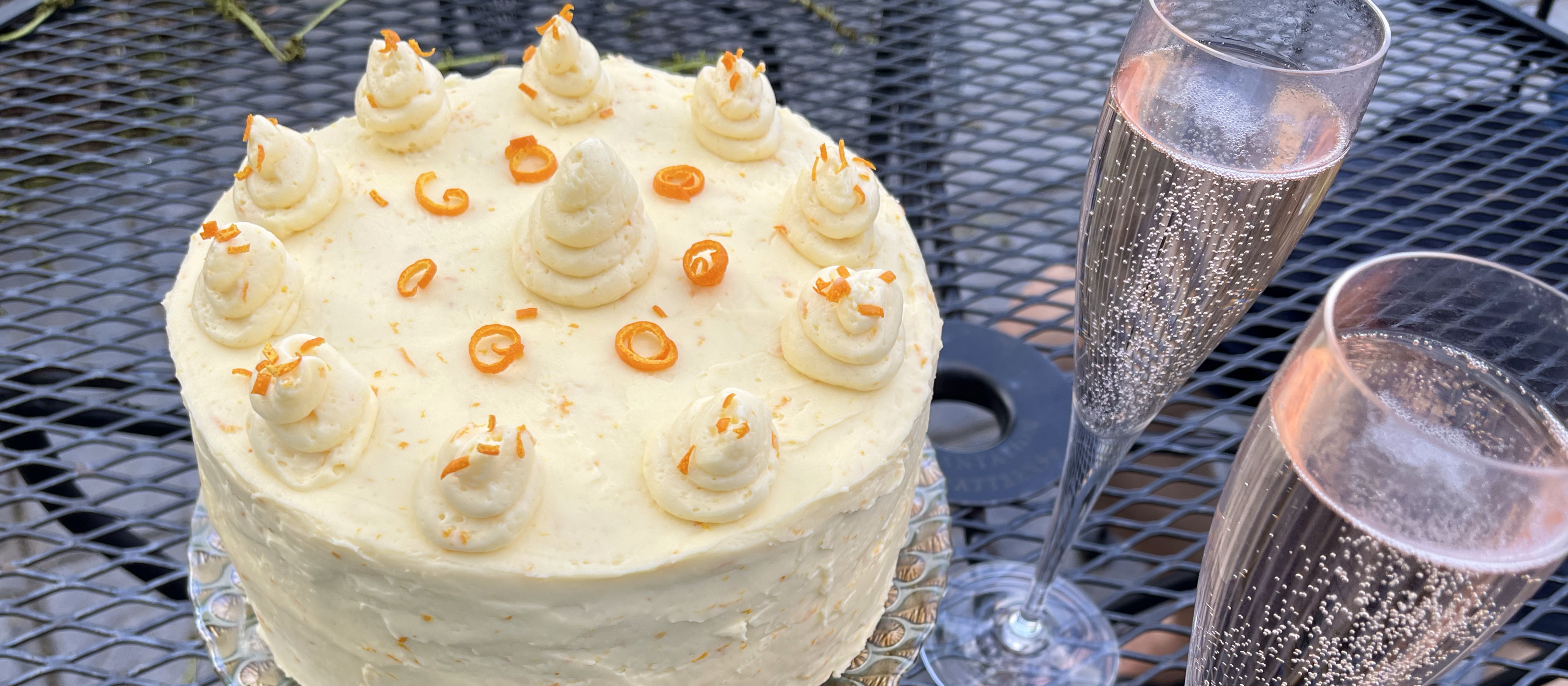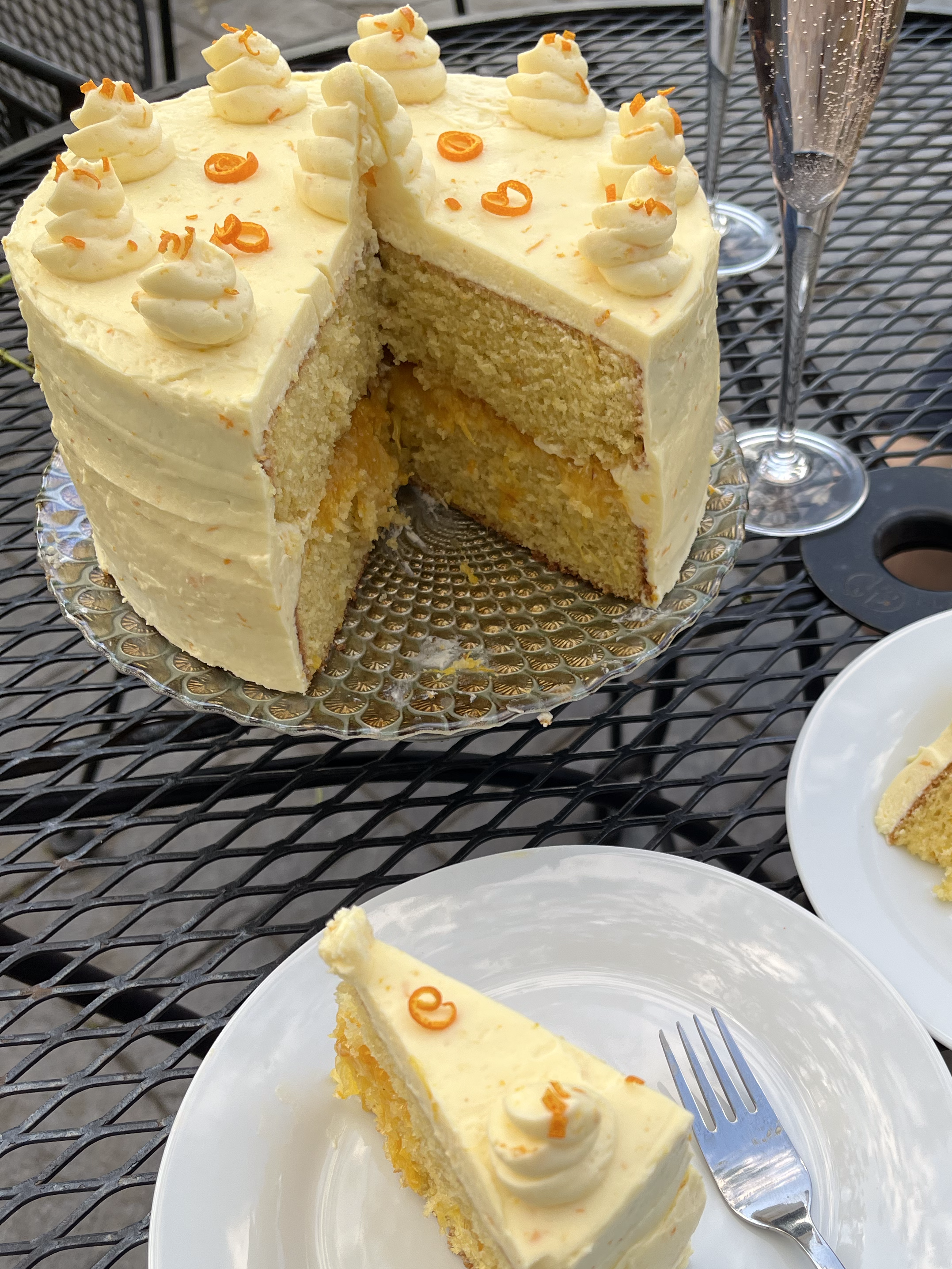There’s a lot going on with this cake: the orange and polenta are the headliner flavors, but there’s also a lot of depth coming from the white wine and olive oil. The complex flavors combined with the slight cornbread-like texture might make this cake a little too much for some. On the other hand, if you’re an adventurous foodie and you give this a try, you’ll be rewarded with a cake that pairs wonderfully with a glass of champagne or sparkling wine, making it the perfect celebration cake.
I first made this cake for a foodie dinner party. A group of us would meet up once a month with a new “secret ingredient” challenge in which each person had to make a dish using the ingredient of the month. White wine was the secret ingredient that month, and I made this sponge as mini cakes and served them with a stabilized whipped cream frosting. They were a hit, but I thought the cake could go further.
By adding the orange jam filling and orange vanilla buttercream frosting, the whole cake gets transformed into a layer cake with the presentation and visual wow-factor that is worthy of the flavors and complexity of this cake. It’s bright and refreshing due to the citrus and buttercream, but still earthy and maybe even a bit grassy depending on your choice of wine and olive oil. While it’s not for everyone and there are some crowds that I would not make this for, I appreciate the unique flavors and it’s one of my favorite cakes.
This recipe makes 1 fantastic 2-layer cake.
Ingredients
For the cake:
- 3/4 cup olive oil
- 3 eggs
- 1 1/2 (297 g) cups sugar
- 3/4 c white wine
- 1 7/8 c (225 g, or 2 cups minus 2 tbsp) all-purpose flour
- 3/4 c (108 g) fine ground polenta (or sub cornmeal)
- 1 1/2 tsp salt
- 1 tbsp baking powder
- zest of 1 orange
For the Vanilla Orange German Buttercream:
- 1 packet of German vanilla pudding (see notes)
- 500 ml milk
- 250 g softened butter
- zest of 1 orange
- 1 pinch of table salt
- 25 grams of sugar to start, up to ~50 grams in total
For the filling:
- 1/2 cup of your favorite orange jam or marmalade (homemade or store bought)
Directions
For the cake:
- Preheat the oven to 350F (180C). Prepare two 7” cake pans by lining the bottoms parchment paper and lightly oil the pans
- In a medium bowl, measure and whisk together the dry ingredients: flour, polenta, baking powder, salt, and orange zest
- In a large bowl, whisk the olive oil, eggs, sugar, and wine until smooth. Pour the dry ingredients over the wet and use a fork to mix into a smooth batter (forks help reduce how much mixing you do and prevent the formation of gluten)
- Pour the batter into the prepared pans and bake for 30 - 40 minutes, rotating the pans half way through. The cakes will be done when you have a clean toothpick or cake tester in the center of the cake, the tops are golden, and the edges are have browned and pulled away from the edge of the pan slightly. Let the cakes cool in their pans for ~10 minutes and then transfer the cakes to a cooling rack to completely cool.
- Optional: If you think you might have over baked your cakes, or simply want a bit more flavor, feel free to brush the top of the cakes with a simple syrup, orange juice, grand marnier, or milk after the cakes have fully cooled. Just make sure to only go over each part once, or else you risk making the cake soggy and prone to falling apart.
For the buttercream
- Prepare the pudding according to the instructions on the package (mix the sugar in to the pudding, then few tablespoons of cold milk to make a smooth paste, then gradually add the rest of the milk while whisking and heat everything until steaming and hold for 5 minutes before turning off the heat. Continue whisking until slightly cooled and place plastic wrap over the top to avoid creating a film as it cools the rest of the way)
- Before continuing, make sure the butter and pudding are the same temperature (both should be at room temperature, 70-80 F). Beat the butter, salt, and extra sugar (if using) using the paddle attachment on a standing mixer until fluffy and pale, scraping down the bowl regularly (medium speed, ~10 min). I use this step to control the sweetness of the buttercream to based on how sweet the cakes turned out so that the two can complement each other
- Whisk the cooled pudding to ensure there are no clumps. You can also strain it if you want to be certain, but I prefer to just whisk. Switch the mixer to the whisk attachment and add a few tablespoons of pudding at a time while the mixer is running on medium-low speed. Halfway through the puddling, add the orange zest. Remember to scrape down the bowl as you go. If at this point you feel the buttercream is not sweet enough, add an additional 1-2 tbsp of sugar before adding the remaining pudding
- Store the buttercream in the fridge until you are ready to use, especially if it’s a warm day. You can make the buttercream a few days in advance if needed
For the assembly:
- Make sure the cakes have completely cooled. If you have a cake stand, put a dollop of buttercream in the center and line the edges using 4 strips of parchment paper. The frosting will help keep the cake in place and parchment will keep your cake stand clean so you can use it for serving.
- If your cakes have a large dome, level the cakes using a sharp serrated knife using long, smooth motions. This can take some practice, but you’ll be able to hide any unevenness using the frosting
- Place 1 cake in the center of the cake stand and scoop all of the orange marmalade onto the center of the cake. Using a small offset spatula, spread the jam across the cake leaving a 1/2” border. Fill the 1/2” border with buttercream using the offset spatula, or by filling ~1 cup of buttercream into a piping bag (or plastic zipper bag) and piping the rim
- Place the second cake over the first, but topside down and gently press down to position. Make sure the cakes are aligned by rotating and visually inspecting the sides
- Apply the crumb coat to the cake. The crumb coat is a thin layer of buttercream applied on the entire cake. This should take less than 1 cup of frosting in total. Once the crumb coat is applied, chill the cake in the fridge for 10 - 20 minutes, until the buttercream has firmed up
- Scoop ~2 cups of buttercream onto the cake and smooth over using the offset spatula. Create a thick layer of buttercream over the top (it’s easier to remove than it is to add more). Add more buttercream to the top and spread it over, now pushing the buttercream over the edges and spreading it on the sides. Alternatively, you can apply the buttercream directly to the sides using your piping bag, if you’re using, and smooth over using the offset spatula. A metal bench scraper can also be helpful here, especially for the sides of the cake. Check the top of the cake to make sure it’s level before you continue smoothing over the buttercream. Keep in mind that less is more when fussing over the frosting. Continue until the whole cake is frosted to your liking.
- If you have any more frosting or orange zest remaining, you can use it to decorate the cake. This is when a piping bag is the most helpful so you can make a few mounds, pipe a message, or add some texture
Notes
Wine & olive oil selection: I like using a Sauvignon Blanc or Chardonnay for this cake, but really any dry white wine will do. Like with any recipe that calls for wine, pick something that you like the flavor of. If you use a cheap wine that taste off, that flavor will be transferred into the dish or dessert you’re making. If you don’t enjoy drinking it, you likely won’t enjoy eating it. This doesn’t mean you need to spend $50 on a fancy bottle, just make sure you don’t settle for something less than appetizing.
Use the same judgement for the olive oil. It’s fine if you want to use an olive oil that packs a lot of flavor, just remember that flavor is going to be mixed with polenta, orange, and your chosen wine. Pick something that will add earthiness but won’t overpower the cake. I prefer something a bit more mellow for the olive oil to avoid off flavors in the cake.
German Pudding Packet I use the Dr. Oetker pudding packets normally found in the grocery stores in Germany and across Europe. They make ~ 2 cups of pudding. You could easily use 2 cups of vanilla pudding from a homemade recipe or from a US packet.

